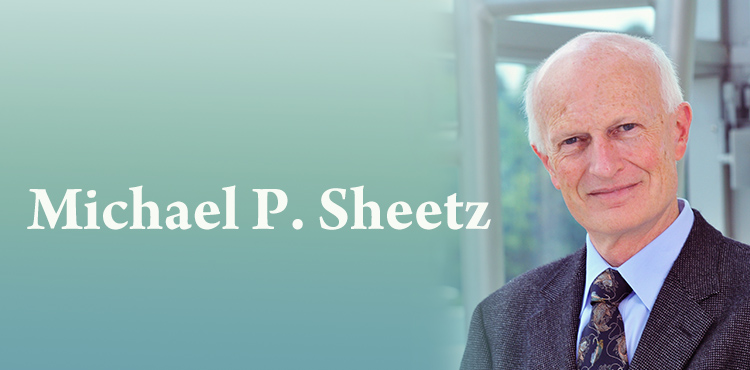
Michael P. Sheetz
Director of RCE in Mechaniobiology, National University of Singapore, Singapore; Department of Biological Sciences, Columbia University, USA
Mechanics and the Physical Chemistry of Cell Functions
As a graduate student with Sunney I. Chan, I learned that the basic principles of physical chemistry were inviolate even for cells and biological systems. ough I find myself far afield from my thesis work with Sunney, the same principles apply and we are finding many aspects of cell mechanics and motility that need to be understood in those terms. For example, control of cell morphology involves the integration of mechanical sensing and different types of cell motility to produce the desired shape of the organism1. Nanometer level analyses of cell behavior have revealed only a limited number of motile functions involving complex mechanochemicalsteps2. For example, cells spreading on matrix-coated surfaces have revealed three distinct types of motility, an initial blebbing, continuous spreading, and periodic contraction motility. During most cellular motility functions, there is assembly of actin filaments at the periphery and movement of the actin centrally at rates of 10-120
nm/s. is raises the question of how the cell senses forces when the environment is constantly dynamic. Long term matrix forces appear to be sensed by protein stretching and we have defined two different cytoplasmic mechanisms. One example is the activation of protein phosphorylation by stretching3. Secondly, the stretching of proteins can unveil binding sites such as the stretching of talin causing the increased binding of vinculin4. Recent findings show that talin is stretched by 200-300 nm and relaxed multiple times in vivo with a stochastic period of 6-16 s5. ese findings indicate that it is not a single stretch but perhaps the integral of many stretches that defines the cellular response to mechanical aspects of the environment.
Because the assembly of talin in adhesion complexes depends upon the rigidity of the surface matrix, the integrated signal from a surface will be a complex function of both the chemical nature of the matrix, rigidity of the matrix and the level of cell motility. ese systems rely on hydrophobic interactions and the integration of stochastic
events.
1 Vogel, V. and Sheetz, M., Nat Rev Mol Cell Biol 7 (4), 265 (2006).
2 B. J. Dubin-aler et al., PLoS ONE 3, e3735 (2008).
3 Sawada, Y. et al., Cell 127 (5), 1015 (2006).
4 del Rio, A. et al., Science 323 (5914), 638 (2009).
5 Margadant, F. et al., Submitted.
Michael Sheetz began his work in membrane biophysics at Caltech, where he earned his Ph.D. in 1972. After a two-year postdoctoral study with Dr. Jon Singer at UC San Diego, he joined the faculty in Physiology at the University of Connecticut Health Center in Farmington, Connecticut. There, as a young faculty member, he initiated a program to study the motions of proteins in biological membranes. His work led to an understanding of how the cytoskeletal matrix apposed to the membrane surface controls cell shape, the movement of proteins in membranes, and how certain protein deficiencies influence membrane cytoskeletal and membrane aberrations. In 1985, Dr. Sheetz moved to the Department of Cell Biology and Physiology, Washington University School of Medicine, St. Louis, Missouri, where he launched his research on myosin-mediated motility in cells. While on sabbatical with Professor James Spudich at Stanford University, he developed the first quantitative in vitro motility assay of cells. This work led to the discovery of kinesin, a molecular motor that drives organelle movements along microtubules in cells. A number of landmark papers followed in the area of cell motility and force sensing. His laboratory developed innovative methods to track kinesin-driven movements with nanometer-scale precision, and introduced single-molecule methods to study membranes, including the application of optical tweezers to measure forces in membranes and the forces that develop during microtubule motility upon activation of kinesin by phosphorylation of kinesin-associated proteins. Since moving to Duke University Medical School, Durham, North Carolina as Professor and Chairman in the Department of Cell Biology in 1990, and subsequently to Columbia University, New York as William R. Kenan, Jr. Professor of Cell Biology and Chair of the Department of Biological Sciences in 2000, Dr. Sheetz has extended his work on cell motility to other molecular motors, introduced genetic methods to the research, and broadened the studies to include many cell types.
Dr. Sheetz has had an illustrious scientific career. He has pioneered and brought many novel technologies to cell biology that have led to a most impressive series of fundamental discoveries with far reaching medical and technological impact, from the development of a new generation of drugs to tissue engineering. Thus, he has shown that he can make important new contributions in many different academic environments, as well as many different disciplines. He has published more than 200 research papers. His papers are highly cited, including two publications with over a 1000 citations. Many of his early contributions on membrane and cellular mechanics are now being revisited, as engineers are beginning to develop methods to create tissues in vitro.
Dr. Sheetz’s scientific contributions have been recognized by numerous awards, including the Javitz Neuroscience Merit Award of the National Institutes of Health (1991-1998); Humboldt Senior Fellowship (1996-2000); Laurens L.M. van Deenan Award (University of Utrecht, 2004), and the Schaller Lecture in Engineering (2006). Currently, he is serving on a number of editorial boards, including Biophysical Journal, and Journal of Membrane Biology. He has previously served as Associate Editor of Annual Review of Biophysics and Biomolecular Structure and the Journal of Neuroscience.

